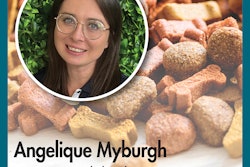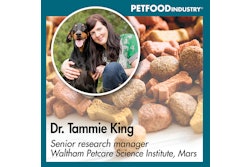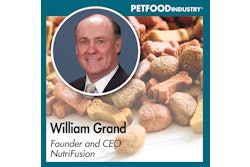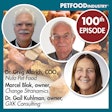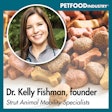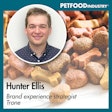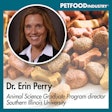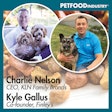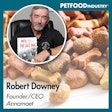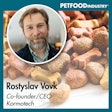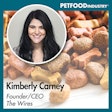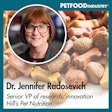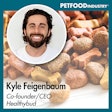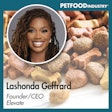
In this episode of Trending: Pet Food, host Lindsay Beaton interviews Zora Tabin, founder of Wild Zora and Zora's Best Friendz, about her transition from the human food industry to pet treats. Tabin discusses how she built a USDA-inspected facility in Colorado to create grass-fed meat and veggie bars for outdoor enthusiasts, then expanded into freeze-dried meals and co-packing services. The conversation explores the regulatory differences between USDA and FDA oversight, the challenges of building a new brand from scratch despite having an existing customer base, and the importance of targeting quality-conscious pet parents who prioritize their dogs' health and nutrition.
The transcript below is from Episode 89 of the Trending: Pet Food podcast, where Zora Tabin, founder of Wild Zora and Zora's Best Friendz, and host Lindsay Beaton explore the unexpected challenges of building a new brand from scratch and the key differences between serving human customers versus quality-conscious pet parents. You can find the episode at Trending: Pet Food Podcast, on SoundCloud or on your favorite podcast platform. This episode originally aired on June 25, 2025.
We want to thank Coperion for sponsoring this podcast. Coperion brings together some of the world's most trusted technology brands to offer innovative system and ingredient automation solutions to pet food producers worldwide.
Lindsay Beaton: Hello and welcome to Trending: Pet Food, the industry podcast where we cover all the latest hot topics and trends in pet food. I'm your host and editor of Pet Food Industry magazine, Lindsay Beaton, and I'm here today with Zora Tabin, owner and founder of Wild Zora and Zora’s Best Friendz. Hi Zora, and welcome.
Zora Tabin: Hi Lindsay, thank you so much for having me.
Beaton: In case you're unfamiliar with Zora or Zora’s Best Friendz, here's what you need to know. Zora is originally the founder of Wild Zora, a woman-owned, family-run business committed to crafting flavorful, nutritious and convenient human food options for active lifestyles. Drawing inspiration from her upbringing on rural farms and a passion for farm-to-table traditions, Zora has spent over 11 years running a USDA-inspected kitchen in Loveland, Colorado, where she uses high-quality natural ingredients such as free-range and grass-fed proteins to create meals and snacks that prioritize wellness and flavor.
Expanding her dedication to wholesome nutrition, Zora launched Zora’s Best Friendz, a line of human-grade, single-ingredient dog treats that meet the same rigorous standards as Wild Zora products. Through her work, Zora continues to provide better food choices for families, outdoor enthusiasts and their furry companions. Zora's experience in the human food space and her jump to the pet treat space are why I've brought her on today to answer this question: How do working in the human food space and the pet treat space compare?
Zora, for these kinds of conversations, I always love a good origin story. So I'm going to start out by asking you how you ended up in the human food space to begin with, and then how did that lead you to the pet treat space?
Tabin: So I have no experience in food making, none in manufacturing. I was a full-time mom and I was a teacher before that. In 2012, we moved from the Czech Republic. I originally come from Czechoslovakia. When it was Czechoslovakia, we were living in the Czech Republic and the UK for a few years with my family. In 2012, we made it to Colorado.
I was thinking, "Okay, what am I going to do here with myself?" The kids were in second and fourth grade. We started to be more outdoor — more skiing, more hiking, all of that. My son is a fourth-grader. He needs more protein. My husband is not celiac, but sensitive to gluten. I'm sensitive to sugar. So everybody had a little bit going on as far as various dietary needs.
Now we're outside and we're hiking. I was thinking, "Okay, we need a protein snack." Let's buy jerky. The jerky is too salty and too tough. I don't like the texture, and it's not grass-fed. By the way, the European Union prohibited the use of growth hormones in cows or anywhere in animals about 20 or 25 years ago. So I'm thinking, "No, I don't want to give my son jerky with growth hormones. Maybe let's do it differently."
So I started in the kitchen at home. No idea what jerky is. I'm grinding this grass-fed meat, putting organic veggies and fruits into it, because I thought it doesn't have to be all meat. Let's put a little bit of carbs in there. Let's put a little bit of veggies in there — more fiber, make it a little more palatable, maybe healthier.
2014-2015 was a whole year of developing, and then, of course, I learned, "Oops, I'm making human-grade food. I have to be in a USDA-inspected facility." What does that mean? Huge learning about that. I found myself a USDA-inspected facility that used to make burritos. If more than 3% of your food is meat, you are under USDA, not under FDA. Huge learning about all of that.
Here we are ... 2015, we finally have our meat bars on the market at a little farmers market, which is a great way to start because it's low cost, you get a lot of feedback from people. Try to have someone else work your booth, not just you, because people don't want to tell you your baby is ugly. So yeah, this is "interesting." "Interesting" is not a good word. What do you want? What do you want to change about it? Blah, blah, blah. So a lot of new R&D, and then we started to sell it further out online in retail stores as well.
That was 2014. So, 2014, we have our own USDA facility. Now we're dehydrating. In 2018, we actually purchased a business called Paleo Meals to Go. So we were on that 2015 paleo trend, and we're making the dehydrated jerky meat bars. We call them meat and veggie bars. Here is this paleo meal company making backpacking food for backpackers. We saw some synergies, and they needed to get out. So we acquired that business, and now we're in freeze-drying, which is a different form of dehydration. You just need completely different machinery.
In 2018, I couldn't find grass-fed or free-range chicken in freeze-dried form. Nobody was making it. Even now it's hard, because these freeze-drying chambers that we have now are huge. If you don't have the demand and people don't want to pay for grass-fed, because usually the survivalist industry is about surviving, not thriving, so it was hard to find.
We got our own, back then smaller machines. We at one point had 24 of them, and they needed an oil change after every run. Talk about how not to do manufacturing, because it was just really hard. So then we started to freeze-dry. Since 2018, now we're also freeze-drying meat. We self-manufacture everything.
I was told many times, "Give it to the co-packers. Have someone else deal with it, just do the marketing." I'm thinking, "No, because you purchase the ingredients, you see the process, you see the quality, you know what you're making at the end of the day." I want to see the process. I want to control the quality. So that was always our decision. Plus, we can help a little bit local community, hire a few people, and that was always important for us to stick to our own manufacturing. So that's what we've been doing.
In 2022, we moved to a new, larger facility that actually has concrete floors. Imagine that — you need that to hold real freeze-drying drums. We're thinking, "Okay, we can't self-produce enough. We need to get bigger machinery." We got deeper into the freeze-drying. Now we're doing backpacking food again. We have the bigger facility with the concrete floors, we got bigger machines, and now we're offering the freeze-drying for other brands as well. So we are now the co-packers, supplying other brands with freeze-dried meat, mainly meat. I mean, we can freeze-dry anything, but we've been mainly focused on the protein.
Then how did we get into the pet? So I am this judgmental mother who is thinking, "Look at these pet people. Really, they should get a life. Maybe they should get kids and do something with their life." Here we are, two years ago, empty nesters, and we turned into these dog people. Our pets are our babies. We want them to live forever. We feed them the best of the best. You know, I cut them my steak, my last bit of ribeye steak. It goes to them. My husband thinks I'm nuts.
But as humans, we need to care for something, for somebody. So even if people maybe have less and less kids, they still have somebody and a pet to take care of. We became these crazy pet people. I'm thinking, "Well, wait a second, we're doing all this protein for humans. Why don't we make our little puppies some beef liver treats as well?" That's how it started. We have the freeze-dryers, we have the puppies. We love them. We want to do it better, differently, cleaner. Maybe I had no idea what's happening in the pet industry back then, but that was sort of the idea — me becoming an empty nester. That's really it.
Beaton: I'm always curious about the transition part, because there are so many trends in the human space that hop over to the pet space. It used to take years for those trends to jump over. Now it's almost immediate. If you see something going on in the human space that could even remotely be applied to pets, sure as anything you're going to see it on the shelves in six months. What did you have to learn about pet in order to start making treats? As you were learning, what did you notice that was very similar to the human food space already?
Tabin: I agree with you. There is this trend called humanization of pets. You go to Expo West, which is all about human food and natural food industry, and then you go to the pet shows such as The Zoo, and you see the similarities. You see even the packaging going light blue, light pink, the baby colors. So that's interesting. So that is definitely happening very, very fast.
The biggest learning curve is obviously for us as producers. Now we're regulated by FDA, not the USDA. So there was some learning about that as well, but understanding how the treats specifically — because we started with the treats — how are they made? How is it made for the pets? Because everything we make is for humans. We buy human-grade liver. Our kill step is heat. It's ovens. But in the pet industry, it's not the same.
For example, you can buy degraded meat, much cheaper ingredient to start with. So if something goes wrong somewhere in a human-grade facility, they can relabel it and degrade it to pet and sell it to the pet industry. Now you're starting with much less of a quality ingredient, and then you're dealing with raw meat. There are still pathogens. So you need to deal with the pathogens, right? How do you do that? There are a few ways.
In the human space, we achieve five-log bacterial reduction with heat. For chicken, it's 165 degrees internal temperature, instantaneous one second. For beef, it's 160 degrees. For liver, it can be 160 degrees instantaneous, or it can also be 140 degrees for 12 minutes. You can do a lower heat — have a medium-rare steak or medium-rare liver for our puppies, but just extend the time, and you will achieve your five-log reduction. This is USDA guideline, Appendix A, and that's what we follow. That's our Bible.
The pet industry doesn't do it because they're not regulated by the USDA. They do it according to FDA. So what are they doing? There's a big learning. They can take the degraded-to-pet meat, and they do a chemical bath. I was thinking, "What's that?" Basically, if you have a slurry, if you grind up the liver, they can inject chemical into it, and that gives you about two-log reduction, some pathogen lower. It doesn't do the five logs.
So what else do they do? Not everybody. They then do — after they form their log of liver — they do HPP, high-pressure pasteurization, which is very expensive machinery. Not every pet brand has it, so it's not always done, and that's why FDA goes around and tests your product: E. coli recall, Listeria recall, Salmonella recalls. But if you do the high-pressure pasteurization, it will give you another three-log reduction. So now you have two plus three. You're at five. But the high-pressure pasteurization also degrades the meat. It changes the color and it takes away the smell.
When we do ours, we just do it your grandma, or you, would cook liver for yourself. My grandma would — every Friday I had to eat it. It's all good. I'm healthy because of grandma. But she would do slowly roasted liver on a frying pan, slow heat so it doesn't turn hard. Then salt at the end so it doesn't turn hard. In Czech, we use a lot of caraway, and we would have that with rye toast. That would be our Friday dinner. In the U.S., people tend to do it more with a lot of onions and maybe gravy, but it's done.
We cook it for the pets the same way we do it for humans in the ovens, lightly roasted, low, slow heat to get the pathogen reduction so it's safe for the person handling it, and also for the puppy or the toddler that happens to be on the floor and goes and licks the dog's bowl. You have to take care of it. I just want to do it the same we do it for humans. I believe it's better. I believe it's healthier for the puppies. There is no chemical residue in the treats, and it is a way to differentiate, I suppose, as well.
Beaton: How were you able to market your product? Did you start out by marketing to your current customers on the human side, or did you try to find a completely different customer base right off the bat?
Tabin: Yes. That's been tough, because especially with liver treats, right? It's a red ocean. Go to Amazon. There are so many. So, it has not been easy. I thought it's going to be easier. "Oh, we're going to market it to the thousands of email list people that we have on the wildzora.com," and it was not very successful.
First of all, we made the decision to separate the brands. We did not want to sell the pet treats under Wild Zora, and I think that was a good decision. But that meant now you're starting a new brand from scratch. Your Instagram is at zero and everything is at zero. You're building a new brand. It has not been as easy as I hoped, to be totally honest, because the humans were not really that interested in the pet treats. They could have been also a little confused on what Zora is doing now. "We don't understand." So I think it's good to keep them separate, but now you are building a brand-new startup.
Beaton: So where have you found your customers to be? There's a lot of conversation in the pet space about where to find your customers, because there are so many spaces online, and there's so many different ways to reach out. Where have you had the most success in reaching people who are looking for the product that you're making?
Tabin: We're not doing any retail yet, because that's costing a lot of money. We're doing it the slow, more measured, cheaper way, which is basically online. We have zorasbest.com. We also sell it on Amazon, because you have to support both platforms. Also the slow way, you know, collecting emails, doing events, interacting with influencers and affiliates. We have also a PR agency. It's more for branding. It might not turn into direct sales immediately. Trying a little bit of Google ads, a little bit of Meta ads. Meta probably less for this brand. It's better for the Wild Zora customer, because they hang out on Facebook more than the pet people really. Digital marketing, website, Amazon — that's how we started.
Beaton: What kind of feedback did you get? The human-grade, high-grade pet treats absolutely have their place in the pet space, and it's very much a trend. What does your customer look like demographically speaking?
Tabin: I think they appreciate the differentiation, but it's a learning, right? Teaching people is expensive, so getting across the message that it's made differently, that it's actually better for your pet, that costs a lot of touchpoints to see it. But it's basically people who are really conscious about what their puppy eats and also when they see the dog's reaction.
As I said, with the HPP, the smell is not there. It just doesn't smell the same. You open our cup — and we keep the treats in a cup, just slightly differentiated packaging, instead of a traditional pouch — and you open it and you're thinking, "Oh my god, that is liver." Yes, it is liver. The dogs just love it, because they can smell it so much more. So we've seen very positive reactions. When people see their puppies eating it, especially a super picky puppy that gets stomach aches and doesn't want to chew on any treats, when they eat it, they're thinking, "Oh yeah, this works" or "Our baby likes it."
Beaton: You've been talking about the challenges, and some of them unexpected, in entering the pet space and getting your product out there. What is something that you had to learn yourself, that you wish somebody had told you at the start, when you decided to start this journey into pet?
Tabin: I think as we were thinking, "Oh, you know, we already have the supply, right? We have the machinery. We know how to make beef liver, blah, blah, blah. It's easy." Having a supply means nothing. Have a demand first, and test it. Because really, to do a — after 11-12 years of doing a food business — this is a cold startup. Maybe people told us. I don't think they did. I would still be thinking, "Yeah, let's try it anyways." But I would be thinking, "Okay, why don't we try the demand first before we worry about the supply?" Because that's the easy part.
Beaton: What is the biggest difference you found between the human and pet consumers of your products? How are you having to communicate with them differently or reach out to them differently? Or is it just a matter of finding the right people and then the communication's the same?
Tabin: I think because we are marketing a lot on the benefits, how differentiated the product is, we tend to stick to that. So I think finding the right platforms, where these people are — I don't think it's so much on the Facebook. Maybe it's more on the Instagram.
I would say it can also be a much younger demographic than what we're used to, because Wild Zora is, I would say, a little 35, definitely 40-plus, because we have a lot of meals for dietary restrictions, people with autoimmune diseases. It's when you're 20 because your body can digest about anything. It's when you're upper 30s. I was thinking, "Oh, I can't digest it. Oh, I can't have dairy, I can't have gluten. Oh, my God, am I going to eat cardboard?" So now Wild Zora has the older, wiser customer, so they're maybe hanging out still on Facebook, and me too. I'm the boomer.
Then I would say the pet is a little younger demographic, and it's a little more playful. So I think the messaging can be a little lighter and playful.
Beaton: I love the idea of talking about the different messaging strategies, because there are people in the pet space who are marketing to multiple demographics and having to have these different messages. Is there one group that you enjoy messaging to more than the other?
Tabin: You know what? To be honest, I don't think I know even enough, but because of the product differentiation, I really am hoping that we can contact maybe the vets or the pet nutritionists and people who are really mindful of what the dog eats and where it's coming from. That's probably going to be our demographic, because we're not going to have the cheapest product out there. That's been one of the findings. If we use human-grade and we follow the USDA guidelines, it costs us more money to make the product. We are definitely less competitive than any other beef slurry liver treat that started with chemical bath and HPP and degraded meat. So we have to be really on the upper end of the quality and talking to the people who care.
Beaton: As we wrap up our conversation, I want to be future-focused. You've talked about the challenges. There's plenty of opportunity out there. You've been doing this for a couple years now. What is your goal for the rest of 2025 in the pet space? What are you hoping to accomplish this year?
Tabin: So we would like to offer under the Zora's Best even higher quality. Obviously, keep cooking it the same way. That's one differentiator. But even go grass-fed, maybe even check out "regenerative," which has been a new buzzword. Check out and really target the top tier of quality.
Also, besides beef liver, maybe add something interesting, other treats, maybe hearts, maybe lamb, maybe chicken, duck liver, stuff like that. Other treats, starting with R&D. It's not all going to happen this year, because that's a lot. But mainly, my main focus is to get it into as many puppies' mouths and some kittens. Our cat eats it — only a little bit and a little bit at a time. I mean, the cats are picky, but sometimes she eats it too. So get it into more mouths.
We can do it because we have other brands that we manufacture for, so we're basically doing the co-packing or white-labeling, right? We make the product. They send us their packaging and we create it for them. So that's another way to spread the word and make sure that puppies are getting the right treat so they can be with us as long as possible. That's really the end goal, right?
My puppy is 12 years old now. We bought a backup puppy. We don't call her backup puppy, but she is the backup puppy. I heard people having a heart attack when their dog dies. This is insane. So I'm thinking, "Honey, you're so attached to the dog. I'm giving you a backup dog." We want them to be with us as long as possible, and starting with good quality treats and food for them is a no-brainer.
Beaton: Well, thank you very much for coming on today, Zora. I am always fascinated to talk to people who began in the human space and made the jump to pet food, because there are a lot of similarities, but there are always some differences and some challenges. I have found that it's ones that people don't expect, for you, thinking you had a ready-made customer base, and then needing to find your own base for a completely different product and starting a new brand. So the same trends are there, but the implementation of those trends can be very different. So thank you very much for coming on to talk about it today.
Tabin: I really appreciate you having me, and thank you so much for your time.
Beaton: Before we go, I always love to do a little plug for my guests. So where can people find more information about you and Zora’s Best Friendz?
Tabin: So Zora’s Best Friendz, that's online. It's zorasbest.com. We are also selling the beef treats on Amazon, so people can find us there. I'm also going to give your listeners their special code for 15% off. It's going to be called trending15 so they can enjoy and try the products too. Find us at Zora's Best and Amazon too.
Beaton: Awesome. Thank you so much.
Tabin: Thank you.
Beaton: That's it for this episode of Trending: Pet Food. You can find us on petfoodindustry.com, SoundCloud or your favorite podcast platform. If you want to chat or have any feedback, I'd love to hear from you. Feel free to drop me an email: [email protected].
Of course, thanks again to our sponsor, Coperion. Coperion brings together some of the world's most trusted technology brands to offer innovative system and ingredient automation solutions to pet food producers worldwide. Once again, I'm Lindsay Beaton, your host and editor of Pet Food Industry magazine, and we'll talk to you next time. Thanks for tuning in!



